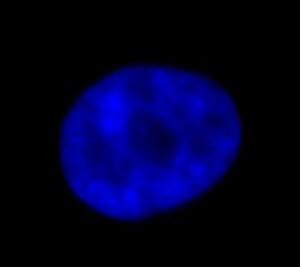Colon cancer prevention – My journey from aspirin to the nucleolus

By Professor Lesley Stark, Personal Chair of Nucleolar Signalling and Cancer Prevention at IGC
Prevention is better than cure is certainly the case for cancer, and especially colorectal cancer.
My journey into the prevention of colorectal cancer started in 1997 as a young postdoctoral scientist, under the wing of Malcolm Dunlop.
The pathway I was studying, the NF-kappaB pathway, was known to be dysregulated in colon cancer and to drive cancer growth. I was very keen to inhibit this pathway and knew that aspirin may have that effect.
I was too impatient to wait on chemical grade aspirin to arrive so walked to a nearby supermarket and bought aspirin tablets. I crushed these up and put them on colon cancer cells in the lab. The next day I looked down the microscope and not surprisingly, the cells were covered in a layer of white chalk.

DAPI fluorescent stain
Unperturbed, I carried on the experiment. I found that aspirin had a very interesting and unexpected effect on the NF-kappaB pathway which I later observed when using pure acetylsalicylic acid (the chemical name for aspirin).
Malcolm was very interested in this finding as there was a lot of evidence to show that long term aspirin use can prevent colon cancer, but how it does this was unknown.
This was the start of my independent career in research aimed at understanding the mechanisms by which aspirin prevents colon cancer. As long term aspirin use is associated with a significant side effect profile, knowing how it may prevent cancer is important so we can identify those that may respond to the agent and safer alternatives.
The next big breakthrough in my career came a few years later when I discovered that aspirin had a profound effect on the cell compartment, the nucleolus.
To visualise cells down the microscope, we stain DNA in cells with a substance called DAPI. When looking at aspirin-treated cells, I noticed that there were large holes in the DAPI stain.
I also noted that these holes were filled with NF-kappaB protein.
It turned out these holes in the DAPI stain were a very important cellular compartment called the nucleolus and that the accumulation of NF-kappaB in the nucleolus caused colon cancer cells to die.
We went on to show that aspirin causes an increase in size and a decrease in number of nucleoli in a cell, and identified a protein that is key to these changes called TIF-IA.
We are now exploring TIF-IA as a biomarker for colon cancer progression and aspirin response. We are also using these specific changes in nucleolar structure to screen for drugs that have a similar effect to aspirin on colorectal cancer.
The changes we see in nucleoli and NF-kappaB after aspirin treatment are also seen in ageing tissue. Given colon cancer is a disease associated with older age, our research is now focussed on understanding the link between nucleolar size, NF-kappaB, inflammation (which is driven by NF-kapaB) and cancer risk.
These studies are moving ever closer to the goal of providing better prevention strategies for colorectal cancer.



